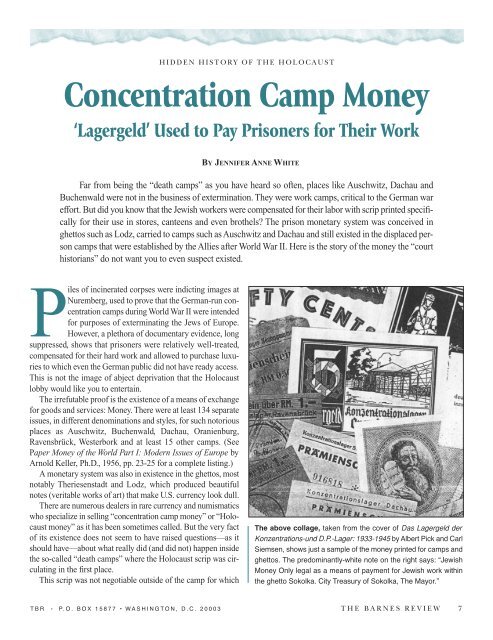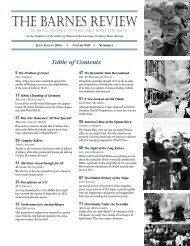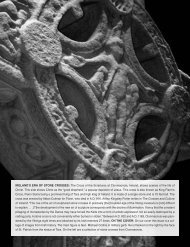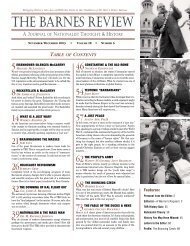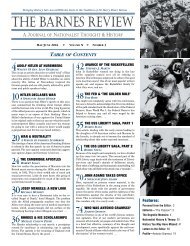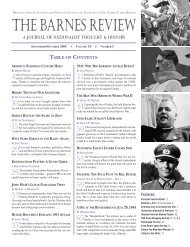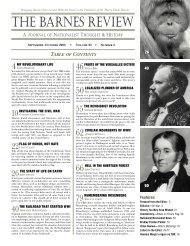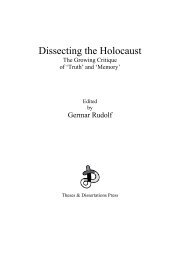Concentration Camp Money - The Barnes Review
Concentration Camp Money - The Barnes Review
Concentration Camp Money - The Barnes Review
Create successful ePaper yourself
Turn your PDF publications into a flip-book with our unique Google optimized e-Paper software.
<strong>Concentration</strong> <strong>Camp</strong> <strong>Money</strong><br />
‘Lagergeld’ Used to Pay Prisoners for <strong>The</strong>ir Work<br />
BY JENNIFER ANNE WHITE<br />
Far from being the “death camps” as you have heard so often, places like Auschwitz, Dachau and<br />
Buchenwald were not in the business of extermination. <strong>The</strong>y were work camps, critical to the German war<br />
effort. But did you know that the Jewish workers were compensated for their labor with scrip printed specifically<br />
for their use in stores, canteens and even brothels? <strong>The</strong> prison monetary system was conceived in<br />
ghettos such as Lodz, carried to camps such as Auschwitz and Dachau and still existed in the displaced person<br />
camps that were established by the Allies after World War II. Here is the story of the money the “court<br />
historians” do not want you to even suspect existed.<br />
Piles of incinerated corpses were indicting images at<br />
Nuremberg, used to prove that the German-run concentration<br />
camps during World War II were intended<br />
for purposes of exterminating the Jews of Europe.<br />
How ever, a plethora of documentary evidence, long<br />
suppressed, shows that prisoners were relatively well-treated,<br />
compensated for their hard work and allowed to purchase luxuries<br />
to which even the German public did not have ready access.<br />
This is not the image of abject deprivation that the Holocaust<br />
lobby would like you to entertain.<br />
<strong>The</strong> irrefutable proof is the existence of a means of exchange<br />
for goods and services: <strong>Money</strong>. <strong>The</strong>re were at least 134 separate<br />
issues, in different denominations and styles, for such notorious<br />
places as Auschwitz, Buchen wald, Dachau, Oran ien burg,<br />
Ravens brück, Westerbork and at least 15 other camps. (See<br />
Paper <strong>Money</strong> of the World Part I: Modern Issues of Europe by<br />
Arnold Keller, Ph.D., 1956, pp. 23-25 for a complete listing.)<br />
A monetary system was also in existence in the ghettos, most<br />
notably <strong>The</strong>r iesenstadt and Lodz, which produced beautiful<br />
notes (veritable works of art) that make U.S. currency look dull.<br />
<strong>The</strong>re are numerous dealers in rare currency and numismatics<br />
who specialize in selling “concentration camp money” or “Holocaust<br />
money” as it has been sometimes called. But the very fact<br />
of its existence does not seem to have raised questions—as it<br />
should have—about what really did (and did not) happen inside<br />
the so-called “death camps” where the Holo caust scrip was circulating<br />
in the first place.<br />
This scrip was not negotiable outside of the camp for which<br />
H I D D E N H I S T O R Y O F T H E H O L O C A U S T<br />
<strong>The</strong> above collage, taken from the cover of Das Lagergeld der<br />
Konzentrations-und D.P.-Lager: 1933-1945 by Albert Pick and Carl<br />
Siemsen, shows just a sample of the money printed for camps and<br />
ghettos. <strong>The</strong> predominantly-white note on the right says: “Jewish<br />
<strong>Money</strong> Only legal as a means of payment for Jewish work within<br />
the ghetto Sokolka. City Treasury of Sokolka, <strong>The</strong> Mayor.”<br />
T B R • P. O . B O X 1 5 8 7 7 • W A S H I N G T O N , D . C . 2 0 0 0 3 T H E B A R N E S R E V I E W 7
INFAMOUS & HIGH-QUALITY CAMP MONEY<br />
DACHAU<br />
“. . . [W]e must remember that like most other<br />
<strong>Concentration</strong> <strong>Camp</strong>s, Dachau also functioned as<br />
a work camp. This explains the appearance of<br />
paper tokens printed in 1944. . . . Dachau’s tokens<br />
were of three different values: 1, 2 and 3 marks.<br />
<strong>The</strong> prisoner’s identification number is written on<br />
the front of this green note, alongside the date<br />
when it was issued, January 31, 1945. In fact, all<br />
of Dachau’s tokens list the prisoners’ identification<br />
numbers.” Stahl, pp. 18-19.<br />
AUSCHWITZ<br />
“At a death camp it would seem that there<br />
was very little need for money.” (<strong>The</strong> Shekel,<br />
Vol XVI, No. 2, March-April 1983, p. 43.)<br />
LODZ<br />
Colors of the different types of currency in<br />
Lodz.<br />
In print runs in 1940, 1942 and 1944:<br />
50 Pfg. Violet<br />
1 RM Olive-green<br />
2 RM Light Brown<br />
5 RM Dark Brown<br />
A Dachau camp note.<br />
THERESIENSTADT<br />
Print-runs for <strong>The</strong>resienstadt Kroner<br />
An Auschwitz camp note.<br />
Denomination Size Color Qty Printed<br />
1 Th. kr. 100x50mm Green 2,242,000<br />
2 Th. kr. 110x55mm Rose 1,019,000<br />
5 Th. kr. 120x58mm Blue 530,000<br />
10 Th. kr. 125x63mm Brown 456,000<br />
20 Th. kr. 135x66mm Green 319,000<br />
50 Th. kr. 140x77mm Dk. Green 159,000<br />
100 Th. kr. 150x77mm Red-brown 279,000<br />
See: <strong>The</strong> Shekel Vol XVI, No. 2, March/April 1983, page 33.<br />
<strong>The</strong>se beautiful <strong>The</strong>resienstadt notes, complete with watermarks, demonstrate the high-quality<br />
artwork and printing of the money.<br />
Lodz ghetto money.<br />
Information from Das Lagergeld der Konzentrations-und D.P.-Lager: 1933-1945 by Albert Pick and Carl Siemsen.<br />
it was issued. This decreased the chance<br />
of a successful escape and made it impossible<br />
for the general public to purchase<br />
some of the rare luxuries available<br />
in the camps. According to Albert Pick<br />
in Das Lagergeld der Konzentrationsund<br />
D.P.-Lager: 1933-1945:<br />
Inmates were not paid for the<br />
work but were given “coupons”<br />
now and then to buy things in the<br />
“Kantine”. . . . As the war progressed<br />
badly and the number of<br />
workers declined, the KZ worker<br />
potential became important. Offers<br />
of “premiums” and other advantages<br />
were made to the<br />
inmates, tobacco was offered and<br />
even visits to bordellos. . . . In<br />
order that these scrips could not be<br />
used outside the camps, special<br />
money was printed.<br />
Letter from Prisoner No. 11647<br />
Block 28/3 Dachau KIII on September<br />
8, 1940 to his relative in<br />
Litzmannstadt (Lodz):<br />
I must write you something<br />
about myself. I am very well. In<br />
the canteen I buy honey, marmalade,<br />
cookies, fruit and other<br />
food. If you worry about me,<br />
you’ll indeed be committing a sin.<br />
I have more reason to worry about<br />
you.. . . (Letters from the Doomed:<br />
<strong>Concentration</strong> <strong>Camp</strong> Correspondence<br />
1940-1945, Richard S.<br />
Geehr.)<br />
<strong>The</strong>re was a payment schedule at<br />
<strong>The</strong>resienstadt utilizing Th. kr. (<strong>The</strong>re -<br />
sienstadt kroner) as the unit of exchange.<br />
(<strong>The</strong> Shekel, Vol. XVI, No. 2,<br />
March-April 1983 p. 29). <strong>The</strong> breakdown<br />
looked like this:<br />
• Working men, according to<br />
their jobs: 105-205 Th. kr.<br />
• Working women, according<br />
to their jobs: 95-205 Th. kr.<br />
• Part-time workers: 80 Th. kr.<br />
8 T B R A L L - H O L O C A U S T I S S U E 2 0 0 9 B A R N E S R E V I E W . C O M • 1 - 8 7 7 - 7 7 3 - 9 0 7 7 O R D E R I N G
• Caretakers: 70 Th. kr.<br />
• War-wounded and holders of the Iron Cross, First<br />
Class degree or higher: 195 Th. kr.<br />
• Prominente (doctors, professors, scientists, wellknown<br />
cultural artists and politicians): 145 Th. kr.<br />
To put this in perspective, a cup of coffee cost 2 Th. kr. <strong>The</strong><br />
circulation in <strong>The</strong> resienstadt was such that it was necessary to<br />
print over 5 million notes. See Papirove Penize Na Uzemi Cesko -<br />
sloven ska 1762-1975, Second Edition, 1975, Hradek Kralove,<br />
trans. by Julius Sem, pp. 134-135.<br />
<strong>The</strong> first worker’s camp to have its own scrip was Oranienburg.<br />
Before using the camp scrip they used German currency<br />
in nearby towns, but the authorities decided to<br />
centralize. Currency was exchanged for camp money, less 30%.<br />
(<strong>The</strong> Shekel, Vol XVI, No. 2, March-April 1983, p. 40. “<strong>Concentration</strong><br />
<strong>Camp</strong> <strong>Money</strong> of the Nazi Holocaust” by Steven Feller.)<br />
Similarly at Buchenwald:<br />
Each prisoner was allowed up to 10 marks per week to<br />
be used for the purchase of cigarettes at the camp canteen,<br />
other canteen purchases, brothel visits, or credit to a savings<br />
account. <strong>The</strong> regulations went on to specify that a visit<br />
to a brothel would cost 2 marks for which 1.5 marks would<br />
be kept by the SS and 0.5 marks would be used for “expenses.”<br />
(Ibid., p. 41.)<br />
Was there a similar situation at all of the other camps—at<br />
least those that issued currency? As this includes Ausch witz, it<br />
would be shocking indeed to even consider marmalade and<br />
cigarettes being purchased in this “death camp.” Even the existence<br />
of money in camps gives us a look at what life was really<br />
like there, yet this information has yet to make it to the<br />
History Channel. ❖<br />
BIBLIOGRAPHY:<br />
American Israel Numismatic Association (Temarac, Florida)<br />
Pick, Albert. Das Lagergeld der Konzentrations-und D.P.-Lager: 1993-<br />
1945, Munich, Battenberg Publishers, 1976.<br />
Schöne, Michael H., Das Papiergeld im besetzten Deutschland 1945-1949,<br />
Regenstauf: Gietl, 1994.<br />
Stahl, Zvi, Jewish Ghettos and <strong>Concentration</strong> <strong>Camp</strong>s’ <strong>Money</strong>, 1933-1945,<br />
London: D. Richman Books, 1990.<br />
SEE ALSO:<br />
<strong>Camp</strong>bell, Lance K., “Dachau concentration camp scrip,” Margate,<br />
Florida: American Israel Numismatic Association, 1992.<br />
<strong>The</strong> Numismatist, April, 1981, by Steven Feller.<br />
Numismatic Scrapbook Magazine, 1965, 1996, “POW <strong>Money</strong> and Medals”<br />
JENNIFER ANNE WHITE is a freelance writer based in Maryland.<br />
FIRST KNOWN CAMP TO USE LAGERGELD<br />
Oranienburg was the first known camp to have lagergeld for its prisoners.<br />
<strong>The</strong> issues for this particular camp were in 5 pfg. (green), 10 pfg. (blue) and<br />
50 pfg. (brown) and 1 mark denominations. (Printed 1933-August, 1934,<br />
when the camp closed.) Unlike <strong>The</strong>resienstadt, these notes were fairly plain<br />
without multiple colors and watermarks. Yet, even these demonstrate the<br />
care and attention given to the design of money for the workers.<br />
by Slabaugh, R. Arlie.<br />
Schultze, Manfred, Unsere Arbeit-unsere Hoffnung: Das Ghetto in Lodz<br />
1940-1945, Schwalmtal: Phil-Creativ, 1995.<br />
Sem, Julius, Standard Catalog of World Paper <strong>Money</strong>, 1977 (<strong>The</strong>reisenstadt<br />
notes)<br />
Shtarot, Vol. I, No. 2, Oct, 1976. Yasha L. Beresiner.<br />
T B R • P. O . B O X 1 5 8 7 7 • W A S H I N G T O N , D . C . 2 0 0 0 3 T H E B A R N E S R E V I E W 9


